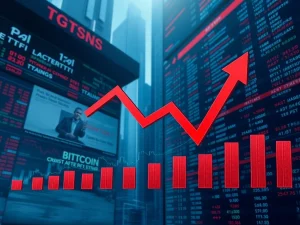Crypto News Today: Breakthrough Regulatory Clarity Fuels Market Optimism

Stay informed with the latest crypto news today. The cryptocurrency market constantly evolves, driven by regulatory shifts, technological advancements, and key industry player sentiments. Today’s headlines bring significant developments from Australia, the United States, and the decentralized finance (DeFi) sector. These events shape the landscape for digital assets globally. Investors and enthusiasts closely watch these trends. Understanding these changes is crucial for navigating the volatile crypto space.
Crypto News Today: Australia’s Progressive Stablecoin Regulation
Australia’s financial regulator, the Australian Securities and Investments Commission (ASIC), has introduced pivotal changes. They eased licensing requirements for entities distributing stablecoins. This move marks a significant step forward for stablecoin regulation Australia. It aims to foster innovation while maintaining robust consumer protections. The new framework simplifies operations for intermediaries. Consequently, it could boost stablecoin adoption within the country.
Easing Licensing Rules for Stablecoin Distributors
ASIC published the ASIC Corporations (Stablecoin Distribution Exemption) Instrument 2025/631. This instrument exempts intermediaries from holding specific licenses. Previously, these entities needed an Australian financial services (AFS) license. They also required market or clearing and settlement facility licenses. Now, if they distribute stablecoins issued by an AFS-licensed entity, these extra licenses are not necessary. This streamlined approach reduces regulatory burdens. It also encourages broader participation in the stablecoin market.
ASIC expresses a clear commitment. They aim to support responsible innovation in the digital assets space. Furthermore, they prioritize strong consumer protections. The regulator ensures eligible stablecoins operate under an AFS license. This structure provides a layer of security. It builds trust in the burgeoning stablecoin ecosystem. This thoughtful approach balances growth with safety.
The exemption specifically applies to stablecoins. These stablecoins must be classified as financial products. This classification falls under the current Corporations Act. They must also originate from eligible AFS-licensed entities. This ensures a regulated foundation for these digital assets. The scope of the exemption is broad. It covers various financial services related to secondary stablecoin distribution. These services include:
- Providing general advice on stablecoins.
- Making a market for stablecoins.
- Dealing in stablecoins (but not issuing them).
- Offering custodial services for stablecoins.
This comprehensive coverage streamlines many aspects of stablecoin operations. It reduces friction for businesses. Ultimately, this progressive stablecoin regulation Australia could position the country as a leader in digital asset adoption. It fosters a more efficient and accessible market for stablecoins. This clarity benefits both businesses and consumers.
US Crypto Bill Gains Momentum: A “Freight Train” Towards Clarity
Across the globe, the United States also sees significant movement. Coinbase CEO Brian Armstrong recently expressed strong optimism. He believes legislation to define crypto’s regulatory oversight has a high chance of passing. This potential US crypto bill would bring much-needed clarity. It would establish which federal agencies police the crypto market. Armstrong’s comments followed productive meetings with lawmakers in Washington D.C. He witnessed robust bipartisan support for the Digital Asset Market Clarity Act. This legislative effort represents a crucial step for the industry.
Coinbase CEO Brian Armstrong’s Optimism for Digital Asset Clarity Act
Armstrong spent several days advocating for market structure legislation. He emphasized its importance for building the crypto industry in America. This bill aims to drive innovation domestically. It also seeks to protect consumers effectively. Furthermore, Armstrong stated it would prevent future regulatory overreach. He specifically referenced past actions by figures like Gary Gensler. Such clear legislation is vital for the industry’s sustainable growth.
I was in DC the last few days working to get MARKET STRUCTURE legislation passed for crypto. This is how we ensure the crypto industry can be built here in America, driving innovation and protecting consumers, and making sure we never have another Gary Gensler trying to take your… pic.twitter.com/UqCH8jCNU8
— Brian Armstrong (@brian_armstrong) September 18, 2025
Armstrong noted strong support within the Senate. Lawmakers from both sides of the aisle are ready to advance this legislation. The draft bill is currently undergoing revisions. It will then be shared with industry participants for public input. This collaborative process ensures a well-rounded and effective framework. The bipartisan backing signals a unified front. It addresses the urgent need for regulatory certainty in the crypto sector.
The Digital Asset Market Clarity Act specifically aims to clarify roles. It defines the responsibilities of the Securities and Exchange Commission (SEC). It also delineates those of the Commodity Futures Trading Commission (CFTC). Other financial agencies would also see their roles defined. This is particularly relevant for non-stablecoins. These include assets like tokenized stocks. Currently, a lack of clear jurisdiction creates uncertainty. This bill seeks to resolve that ambiguity. It provides a predictable environment for crypto businesses.
Armstrong’s confidence is palpable. He believes this US crypto bill has an excellent chance of passing. He stated, “I’ve actually never been more bullish on the market structure [bill] getting passed; it’s a freight train leaving the station.” This strong sentiment reflects a growing consensus. Lawmakers recognize the importance of establishing a clear regulatory path. Such legislation is crucial for American innovation and global competitiveness in the digital asset space. It signals a shift towards a more mature regulatory stance.
Wormhole Tokenomics Overhaul: Boosting Staker Yields and Governance
Beyond regulation, the DeFi sector also sees significant developments. Wormhole, a leading interoperability protocol, announced major updates. These changes affect the Wormhole tokenomics for its native Wormhole (W) token. The overhaul introduces a token reserve. It also offers higher yields for stakers. These revisions could profoundly impact the protocol’s governance structure. Staked W tokens grant voting power to delegates. Therefore, changes to staking incentives directly influence decision-making processes within the Wormhole ecosystem.
Strategic Enhancements to the W Token Ecosystem
Wormhole facilitates asset transfers between various blockchains. It acts as a crucial bridge in the multi-chain world. The protocol aims to enhance its utility and attract more participants. According to a recent announcement, three main changes are coming to the Wormhole token:
- W Reserve: A new reserve will be funded with protocol fees and revenue. This provides a sustainable mechanism for ecosystem growth.
- Increased Staking Yields: Stakers will receive a 4% base yield. Active ecosystem participants will earn even higher rewards. This incentivizes long-term holding and engagement.
- Biweekly Unlocks: The token unlock schedule shifts from bulk unlocks to biweekly releases. This change aims for more predictable supply management.
Wormhole Contributors articulated their ambitious goals. They seek to significantly expand asset transfer and messaging volume. This growth target spans the next 1-2 years. These strategic adjustments to Wormhole tokenomics support this vision. They aim to create a more robust and attractive ecosystem for users and developers. Increased token locking is expected as adoption grows. Revenue will then filter back to the company and the reserve.
Wormhole launched in late 2020. It initially served as a bridge between Ethereum and Solana. Its native token, W, debuted on April 3, 2024. The recent tokenomics revision sparked a positive market reaction. The token price jumped over 6.3% on Wednesday. This immediate surge indicates investor confidence. They clearly approve of the protocol’s strategic direction. The changes signal a commitment to long-term value creation. They also enhance participation incentives. This makes the W token more appealing to a broader audience.

Broader Market Implications: Understanding Bitcoin Price Impact
These individual developments collectively influence the broader cryptocurrency market. Regulatory clarity, particularly in major economies, often leads to increased institutional adoption. This, in turn, can have a significant Bitcoin price impact. As stablecoins gain regulatory acceptance in Australia, more traditional financial entities might enter the digital asset space. Similarly, a clear regulatory framework in the US could unlock massive institutional capital. This capital has largely remained on the sidelines due to uncertainty. Such inflows typically strengthen market foundations.
How Policy and Innovation Drive Crypto’s Future
The optimism surrounding the US crypto bill contributes to positive market sentiment. A well-defined regulatory environment reduces risk perception. This encourages both retail and institutional investors. Bitcoin, as the market’s benchmark asset, often responds positively to such developments. Its price movements frequently set the tone for the entire crypto ecosystem. Therefore, legislative progress in the US is a critical factor for future market growth. It provides a clearer path for innovation. It also ensures consumer protection.
The enhancements to Wormhole tokenomics demonstrate the continuous evolution of DeFi. Protocols are actively refining their models. They aim to attract and retain users. They also seek to ensure long-term sustainability. Successful DeFi innovations often create a positive ripple effect. They draw more participants into the broader crypto space. This growth in decentralized finance strengthens the overall utility and value proposition of cryptocurrencies. It consequently supports the upward trajectory of assets like Bitcoin and major altcoins.
Ultimately, these stories highlight a maturing industry. Regulators worldwide are grappling with digital assets. They seek frameworks that balance innovation with investor safety. Simultaneously, innovative projects continue to push technological boundaries. They create more robust and attractive ecosystems. This dual progress fosters a more stable and predictable environment. Such stability is essential for sustained growth. It also helps in mitigating extreme volatility. Consequently, it influences the overall Bitcoin price impact and market health.
The convergence of clear regulatory pathways and continuous technological innovation paints a promising picture. It suggests a future where digital assets integrate more deeply into the global financial system. Staying informed about these crucial shifts remains paramount for anyone involved in the crypto market. Today’s news reflects a significant step forward in this ongoing journey. These developments reinforce the industry’s trajectory towards mainstream acceptance and widespread utility.









